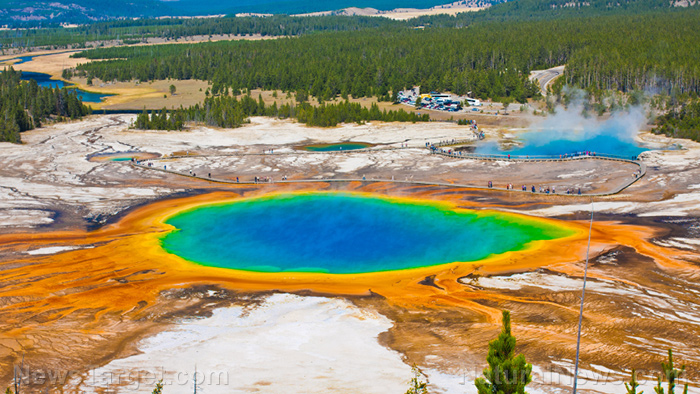
Advertisement
Yellowstone National Park is one of America’s most treasured natural resources – its incredible geysers, among other breathtaking features, drawing millions of visitors to the park every single year. But what a great many may not realize is that Yellowstone is actually a “super” volcano that will one day undergo a massive eruption – and as of late, the terrain surrounding it has been rumbling up a storm in terms of earthquake activity.
More than 200 earthquakes, in fact, were reported to have struck the area around Yellowstone between February 8 – 15, according to the United States Geological Survey (USGS). This high frequency of quakes in such a short period of time is unprecedented, raising fresh fears about the stability of the super volcanic land mass, which some experts believe is beginning to show signs of a potentially imminent eruption called the “big one.”
The area seeing the most activity is located about eight miles northeast of West Yellowstone, Montana, though many of these relatively tiny quakes didn’t even show up on the official seismometers. They were, however, picked up by other detection equipment, news of which quickly spread across the internet.
“Swarms typically have two ultimate causes: shifting at major tectonic plates; or movements of water, gas or magma under the surface,” reports LiveScience.com. “As the abundance of hot springs and mud pots reveals, Yellowstone has plenty of fluid and gas just beneath the ground’s surface. Yellowstone is also in a region that is being stretched and pulled apart, according to the USGS.”

Natural disasters like earthquakes and volcanic eruptions could happen at any moment. Stay informed and prepared by visiting Preparedness.news.
An even bigger earthquake swarm occurred at Yellowstone last summer
This wouldn’t be the first time that Yellowstone has started moving in frequent, rapid succession. Last summer beginning in June, an earthquake swarm struck the Yellowstone area and didn’t really stop until about three months later. The tally of tremors from that swarm event reportedly topped 2,400, which is even bigger than this most recent swarm.
But people really shouldn’t worry, according to Michael Poland, the scientist-in-charge at USGS’s Yellowstone Volcano Observatory in Vancouver, Washington. While increased seismic activity is normally something to pay attention to, Poland wants the public to be at ease, suggesting that this is not indicative of an imminent mega-quake.
“This is what Yellowstone does,” he reportedly stated. “This is Yellowstone being Yellowstone. It experiences swarms all the time.”
According to the National Park Service (NPS), the Yellowstone area is hit by anywhere between 1,000 and 3,000 quakes annually, and these oftentimes occur as cluster swarms like the one that recently occurred there. The biggest quake on record thus far is a 7.3-magnitude one that occurred back in 1959 at Hebgen Lake, a 15-mile-long, four-mile-wide fishing lake in Montana.
“This particular area, especially, is a hotbed of swarm seismicity, and it has been for quite a while,” Poland adds, further attempting to diffuse the thought that Yellowstone is overdue for a massive quake-eruption. “One of the potential explanations for why this area is so swarmy is that the whole crust in the area is still adjusting to the big earthquake in 1959.”
Still, there’s no saying for sure what could happen, as Yellowstone is a highly unpredictable landscape where anything is possible. And even if there isn’t a mega-quake anytime soon, there’s always the possibility of another Hebgen Lake-type quake that could strike that area at any moment, which means people need to be prepared.
“When they do happen, they’re going to shake the region pretty severely, so people should be prepared for that,” Poland says, noting that should the volcano itself blow, ash would quickly spread and devastate large swaths of the country.
Sources for this article include:
Submit a correction >>
This article may contain statements that reflect the opinion of the author
Advertisement
Advertisements















